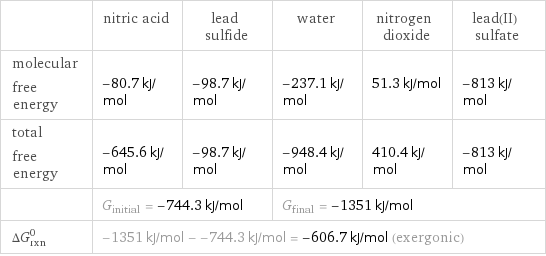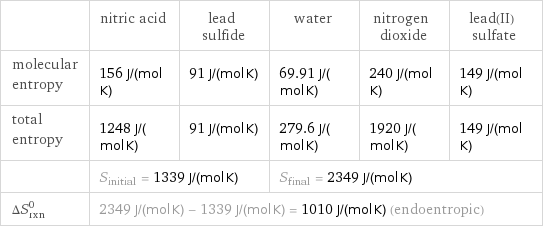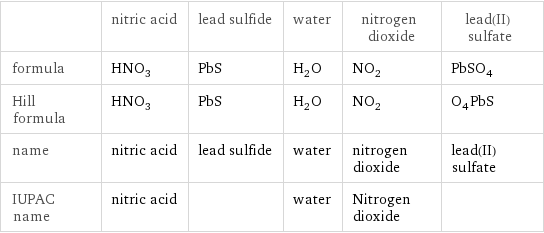Input interpretation

HNO_3 (nitric acid) + PbS (lead sulfide) ⟶ H_2O (water) + NO_2 (nitrogen dioxide) + PbSO_4 (lead(II) sulfate)
Balanced equation

Balance the chemical equation algebraically: HNO_3 + PbS ⟶ H_2O + NO_2 + PbSO_4 Add stoichiometric coefficients, c_i, to the reactants and products: c_1 HNO_3 + c_2 PbS ⟶ c_3 H_2O + c_4 NO_2 + c_5 PbSO_4 Set the number of atoms in the reactants equal to the number of atoms in the products for H, N, O, Pb and S: H: | c_1 = 2 c_3 N: | c_1 = c_4 O: | 3 c_1 = c_3 + 2 c_4 + 4 c_5 Pb: | c_2 = c_5 S: | c_2 = c_5 Since the coefficients are relative quantities and underdetermined, choose a coefficient to set arbitrarily. To keep the coefficients small, the arbitrary value is ordinarily one. For instance, set c_2 = 1 and solve the system of equations for the remaining coefficients: c_1 = 8 c_2 = 1 c_3 = 4 c_4 = 8 c_5 = 1 Substitute the coefficients into the chemical reaction to obtain the balanced equation: Answer: | | 8 HNO_3 + PbS ⟶ 4 H_2O + 8 NO_2 + PbSO_4
Structures

+ ⟶ + +
Names

nitric acid + lead sulfide ⟶ water + nitrogen dioxide + lead(II) sulfate
Reaction thermodynamics
Gibbs free energy

| nitric acid | lead sulfide | water | nitrogen dioxide | lead(II) sulfate molecular free energy | -80.7 kJ/mol | -98.7 kJ/mol | -237.1 kJ/mol | 51.3 kJ/mol | -813 kJ/mol total free energy | -645.6 kJ/mol | -98.7 kJ/mol | -948.4 kJ/mol | 410.4 kJ/mol | -813 kJ/mol | G_initial = -744.3 kJ/mol | | G_final = -1351 kJ/mol | | ΔG_rxn^0 | -1351 kJ/mol - -744.3 kJ/mol = -606.7 kJ/mol (exergonic) | | | |
Entropy

| nitric acid | lead sulfide | water | nitrogen dioxide | lead(II) sulfate molecular entropy | 156 J/(mol K) | 91 J/(mol K) | 69.91 J/(mol K) | 240 J/(mol K) | 149 J/(mol K) total entropy | 1248 J/(mol K) | 91 J/(mol K) | 279.6 J/(mol K) | 1920 J/(mol K) | 149 J/(mol K) | S_initial = 1339 J/(mol K) | | S_final = 2349 J/(mol K) | | ΔS_rxn^0 | 2349 J/(mol K) - 1339 J/(mol K) = 1010 J/(mol K) (endoentropic) | | | |
Equilibrium constant
![Construct the equilibrium constant, K, expression for: HNO_3 + PbS ⟶ H_2O + NO_2 + PbSO_4 Plan: • Balance the chemical equation. • Determine the stoichiometric numbers. • Assemble the activity expression for each chemical species. • Use the activity expressions to build the equilibrium constant expression. Write the balanced chemical equation: 8 HNO_3 + PbS ⟶ 4 H_2O + 8 NO_2 + PbSO_4 Assign stoichiometric numbers, ν_i, using the stoichiometric coefficients, c_i, from the balanced chemical equation in the following manner: ν_i = -c_i for reactants and ν_i = c_i for products: chemical species | c_i | ν_i HNO_3 | 8 | -8 PbS | 1 | -1 H_2O | 4 | 4 NO_2 | 8 | 8 PbSO_4 | 1 | 1 Assemble the activity expressions accounting for the state of matter and ν_i: chemical species | c_i | ν_i | activity expression HNO_3 | 8 | -8 | ([HNO3])^(-8) PbS | 1 | -1 | ([PbS])^(-1) H_2O | 4 | 4 | ([H2O])^4 NO_2 | 8 | 8 | ([NO2])^8 PbSO_4 | 1 | 1 | [PbSO4] The equilibrium constant symbol in the concentration basis is: K_c Mulitply the activity expressions to arrive at the K_c expression: Answer: | | K_c = ([HNO3])^(-8) ([PbS])^(-1) ([H2O])^4 ([NO2])^8 [PbSO4] = (([H2O])^4 ([NO2])^8 [PbSO4])/(([HNO3])^8 [PbS])](../image_source/76cd1dcf8160e5d14dd23ab58a9ed183.png)
Construct the equilibrium constant, K, expression for: HNO_3 + PbS ⟶ H_2O + NO_2 + PbSO_4 Plan: • Balance the chemical equation. • Determine the stoichiometric numbers. • Assemble the activity expression for each chemical species. • Use the activity expressions to build the equilibrium constant expression. Write the balanced chemical equation: 8 HNO_3 + PbS ⟶ 4 H_2O + 8 NO_2 + PbSO_4 Assign stoichiometric numbers, ν_i, using the stoichiometric coefficients, c_i, from the balanced chemical equation in the following manner: ν_i = -c_i for reactants and ν_i = c_i for products: chemical species | c_i | ν_i HNO_3 | 8 | -8 PbS | 1 | -1 H_2O | 4 | 4 NO_2 | 8 | 8 PbSO_4 | 1 | 1 Assemble the activity expressions accounting for the state of matter and ν_i: chemical species | c_i | ν_i | activity expression HNO_3 | 8 | -8 | ([HNO3])^(-8) PbS | 1 | -1 | ([PbS])^(-1) H_2O | 4 | 4 | ([H2O])^4 NO_2 | 8 | 8 | ([NO2])^8 PbSO_4 | 1 | 1 | [PbSO4] The equilibrium constant symbol in the concentration basis is: K_c Mulitply the activity expressions to arrive at the K_c expression: Answer: | | K_c = ([HNO3])^(-8) ([PbS])^(-1) ([H2O])^4 ([NO2])^8 [PbSO4] = (([H2O])^4 ([NO2])^8 [PbSO4])/(([HNO3])^8 [PbS])
Rate of reaction
![Construct the rate of reaction expression for: HNO_3 + PbS ⟶ H_2O + NO_2 + PbSO_4 Plan: • Balance the chemical equation. • Determine the stoichiometric numbers. • Assemble the rate term for each chemical species. • Write the rate of reaction expression. Write the balanced chemical equation: 8 HNO_3 + PbS ⟶ 4 H_2O + 8 NO_2 + PbSO_4 Assign stoichiometric numbers, ν_i, using the stoichiometric coefficients, c_i, from the balanced chemical equation in the following manner: ν_i = -c_i for reactants and ν_i = c_i for products: chemical species | c_i | ν_i HNO_3 | 8 | -8 PbS | 1 | -1 H_2O | 4 | 4 NO_2 | 8 | 8 PbSO_4 | 1 | 1 The rate term for each chemical species, B_i, is 1/ν_i(Δ[B_i])/(Δt) where [B_i] is the amount concentration and t is time: chemical species | c_i | ν_i | rate term HNO_3 | 8 | -8 | -1/8 (Δ[HNO3])/(Δt) PbS | 1 | -1 | -(Δ[PbS])/(Δt) H_2O | 4 | 4 | 1/4 (Δ[H2O])/(Δt) NO_2 | 8 | 8 | 1/8 (Δ[NO2])/(Δt) PbSO_4 | 1 | 1 | (Δ[PbSO4])/(Δt) (for infinitesimal rate of change, replace Δ with d) Set the rate terms equal to each other to arrive at the rate expression: Answer: | | rate = -1/8 (Δ[HNO3])/(Δt) = -(Δ[PbS])/(Δt) = 1/4 (Δ[H2O])/(Δt) = 1/8 (Δ[NO2])/(Δt) = (Δ[PbSO4])/(Δt) (assuming constant volume and no accumulation of intermediates or side products)](../image_source/5f50dd058fd37150e270d60e6f37cfd8.png)
Construct the rate of reaction expression for: HNO_3 + PbS ⟶ H_2O + NO_2 + PbSO_4 Plan: • Balance the chemical equation. • Determine the stoichiometric numbers. • Assemble the rate term for each chemical species. • Write the rate of reaction expression. Write the balanced chemical equation: 8 HNO_3 + PbS ⟶ 4 H_2O + 8 NO_2 + PbSO_4 Assign stoichiometric numbers, ν_i, using the stoichiometric coefficients, c_i, from the balanced chemical equation in the following manner: ν_i = -c_i for reactants and ν_i = c_i for products: chemical species | c_i | ν_i HNO_3 | 8 | -8 PbS | 1 | -1 H_2O | 4 | 4 NO_2 | 8 | 8 PbSO_4 | 1 | 1 The rate term for each chemical species, B_i, is 1/ν_i(Δ[B_i])/(Δt) where [B_i] is the amount concentration and t is time: chemical species | c_i | ν_i | rate term HNO_3 | 8 | -8 | -1/8 (Δ[HNO3])/(Δt) PbS | 1 | -1 | -(Δ[PbS])/(Δt) H_2O | 4 | 4 | 1/4 (Δ[H2O])/(Δt) NO_2 | 8 | 8 | 1/8 (Δ[NO2])/(Δt) PbSO_4 | 1 | 1 | (Δ[PbSO4])/(Δt) (for infinitesimal rate of change, replace Δ with d) Set the rate terms equal to each other to arrive at the rate expression: Answer: | | rate = -1/8 (Δ[HNO3])/(Δt) = -(Δ[PbS])/(Δt) = 1/4 (Δ[H2O])/(Δt) = 1/8 (Δ[NO2])/(Δt) = (Δ[PbSO4])/(Δt) (assuming constant volume and no accumulation of intermediates or side products)
Chemical names and formulas

| nitric acid | lead sulfide | water | nitrogen dioxide | lead(II) sulfate formula | HNO_3 | PbS | H_2O | NO_2 | PbSO_4 Hill formula | HNO_3 | PbS | H_2O | NO_2 | O_4PbS name | nitric acid | lead sulfide | water | nitrogen dioxide | lead(II) sulfate IUPAC name | nitric acid | | water | Nitrogen dioxide |